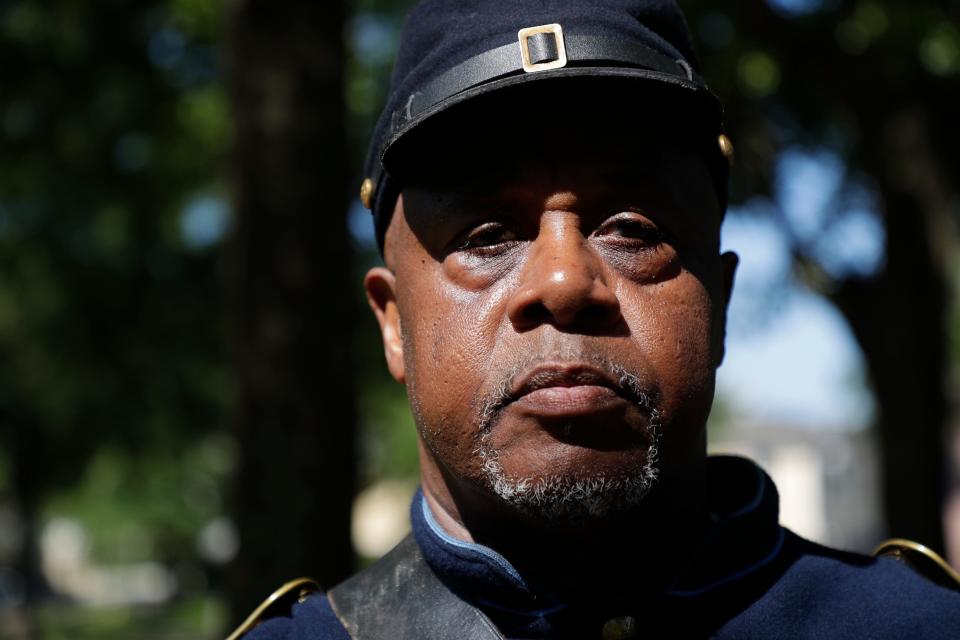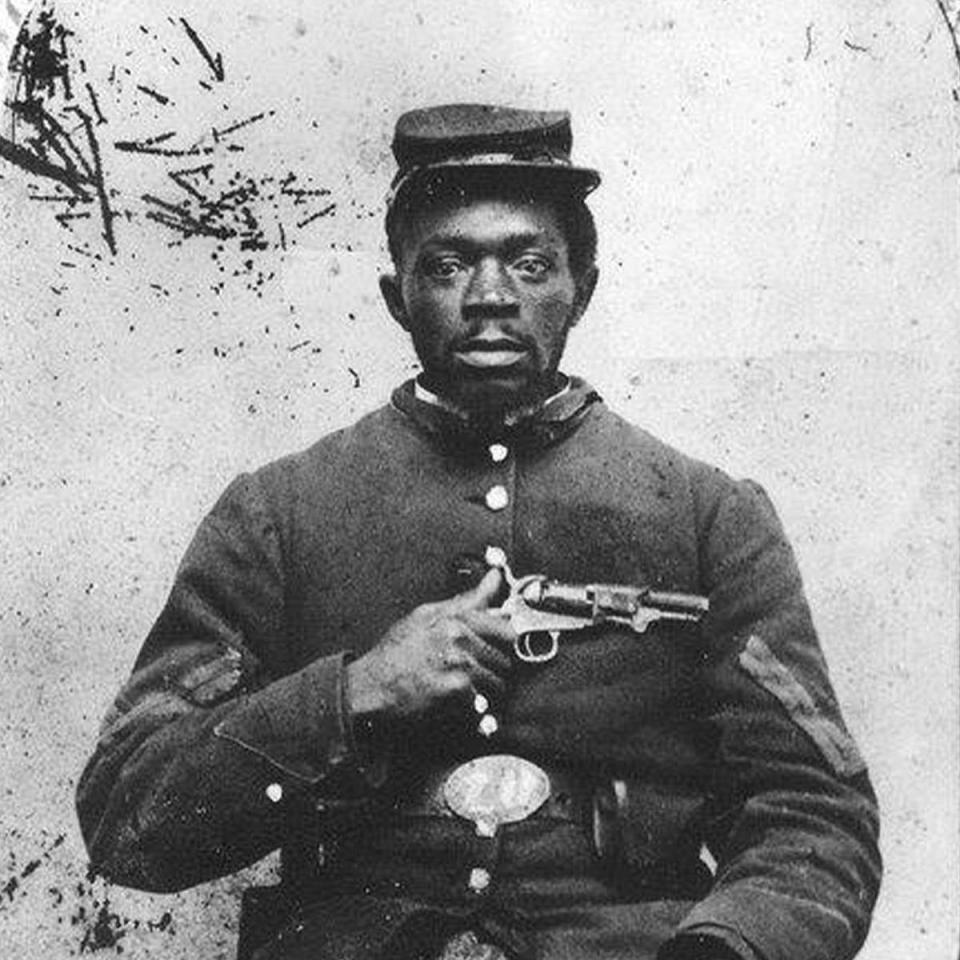Battle of Natural Bridge reenactment: 'A real face on the battlefield' | TLH 200
On March 6, 1865, Tallahassee became the only capital east of the Mississippi to withstand the United States Army during the Civil War.
“The story of the battle is almost always told as an inspiring tale of local resistance,” wrote Democrat writer Gerald Ensley in 2017. “It is told as a story of senior citizen militias and teenage cadets, banding together to fight off the Yankee hordes. It is a tale told around local campfires by those lauding their ancestors’ bravery in the Confederate cause.”
"It’s a nice story. But it’s only partly true," Ensley continued. "The Battle of Natural Bridge was largely won by active duty Confederate troops. Only a handful of volunteer and militia participants – brought in as emergency troops – did any actual fighting."
The victory remains a point of pride for some locals, but for almost half of the population of Florida, the win was a devastating loss.
“The American Civil War has also been called the War Between the States, the War of Northern Aggression, and the War of the Rebellion. But for thousands of slaves – most of them of African descent – it was the Freedom War,” wrote Jarvis Rosier, the Tallahassee president of the 2nd Infantry Regiment U.S. Colored Troops Reenactment Unit & Living History Association, in a pamphlet titled the "Black in Blue and Gray."
During the Civil War, out of the 140,000 people living in Florida, 63,000 were Black. Of those 63,000, 62,000 were enslaved.
Florida wasn’t of strategic significance compared to other southern states during the war, but it was still important because of its beef and salt supplies. Its coastline was also a way for Confederates to avoid the U.S. blockades in the Gulf of Mexico and the Atlantic Ocean.

The largest battle in Florida was in Olustee in 1864. A Confederate army of 5,000 pushed 5,500 U.S. troops headed to Tallahassee back to Jacksonville. In comparison, fewer than 2,000 troops fought at Natural Bridge.
“The win gives local flavor to a strategically insignificant battle,” said Andrew Lang, a history professor at Mississippi State University. “Lost Cause adherents are able to use the battle as evidence of dedicated white Floridians in defense of the state.”
The Lost Cause narrative that Southern states, including Florida, seceded for just and heroic reasons and not slavery is a harmful myth, Lang says.
Mississippi's secession articles states: “Our position is thoroughly identified with the institution of slavery – the greatest material interest of the world.”
As President of Florida’s secession convention, John C. McGehee declared on January 5, 1861, that he believed remaining in the United States meant allowing rule by those who were "sectional, irresponsible to us, and driven on by an infuriated fanatical madness that defies all opposition" and who would "destroy every vestige of right growing out of property in slaves."
“If we listen to the words of those in the past in real time, they tell you what they were doing and why they were doing it,” Lang said. “It’s not a random occurrence that it was the third state to secede behind South Carolina and Mississippi.”
A short lived victory and two historical markers
While the Natural Bridge victory did keep the Florida capital in the Confederacy, it was short-lived. The state would officially surrender less than two months later. U.S. troops took over Tallahassee and immediately raised the American flag. At the time, enslaved people made up 75% of the population of Leon County.
Natural Bridge could have been more significant in the scheme of the war if the U.S. had captured Tallahassee, especially since the invading army comprised the U.S. Colored Troops, the 2nd and the 99th regiments.

The 2nd and the 99th were from Virginia and Louisiana, respectively. The 99th was made up of formerly enslaved people, the Corps d’Afrique. Originally a regiment of engineers who built bridges and roads, the 99th’s first battle was Natural Bridge.
Black troops fought in 17 battles, raids and skirmishes in Florida during the Civil War, Rosier told the Tallahassee Democrat in an interview.
At Natural Bridge, there are two historical markers commemorating the battle. One was put up by the United Daughters of the Confederacy in the 1920s, a move that historians say segregationists used to intimidate Black people during Jim Crow.
“Lest We Forget” reads the stone monument, which honors the “brave men and boys who, in the hour of sudden danger, rushed from home, desk and field and from the West Florida Seminary and joining a few disciplined troops by their united valor and patriotism saved their capital from the invaders…”
The second marker, made of granite and smaller than the first, was installed in 2000 by the Natural Bridge Historical Society. The marker includes the names of all the soldiers who died in the battle, not just the Confederates, said Bob Trapp, secretary and treasurer for the historical society.
Twenty-four soldiers died at Natural Bridge, with 21 killed on the Union side.
“History is history, you should tell the facts,” Trapp said.
A partnership with the Riley House to 'put a real face on the battlefield'
Trapp has been a part of the battle’s reenactment since the early '80s. He dresses in his Confederate greys every year and relishes sitting by the campfire with his friends.
Trapp and the Natural Bridge Historical Society reached out to the John G. Riley House & Museum, and the two have partnered for the reenactment for almost 15 years. In 2010, Rosier put together the U.S. 2nd and 99th regiments to participate in the Natural Bridge reenactment, to "put a real face on the battlefield," he said.
"We try to give an accurate portrayal of what actually happened,” Trapp said.
At the reenactment, Rosier teaches the history of the 2nd and 99th regiments, their involvement in Natural Bridge, and the impact of the U.S. Colored Troops in the Civil War. There were 209,143 Black soldiers in the U.S. Army and Navy, said Rosier, who is also a former sergeant major in the army.
"Who would be free themselves must strike the blow.... I urge you to fly to arms and smite to death the power that would bury the Government and your liberty in the same hopeless grave. This is your golden opportunity," said Frederick Douglass in Syracuse, New York in 1863 to rally Black troops to the cause.
Rosier, whose Tallahassee roots run generations deep, says the reenactment provides a venue for people to learn about an often overlooked part of Black history. He said many still aren’t aware of the contributions from formerly enslaved people during the Civil War, especially on the battlefield.
When Rosier presents, "there's a 'wow' sentiment, because it's not in our history books," he said, and people have come and visited the Riley House after the reenactment to learn more about African Americans' fight for freedom in Florida and Tallahassee.
“I tell people that nobody can tell your history better than you, and no one can tell this authentic history better than us,” he said.
Battle of Natural Bridge reenactment: A schedule of events
March 1, 2024
Reenactor registration and set-up
March 2, 2024
9 a.m. – Military and civilian camps open to the public
10 a.m. – Infantry drill & field demonstrations
11 a.m. – Medical demonstration
12 p.m. – Historical presentations under the ball tent – John G. Riley Center/Museum of African American History and Culture – Oration of Frederick Douglass by John Anderson
1 p.m. – Ladies Tea
1:30 p.m. – Artillery demonstration
3 p.m. – Skirmish on the battlefield
4:30 p.m. – Military and civilian camps closed to the public
5 p.m. – Annual meeting of the Natural Bridge Historical Society, Inc. under the ball tent – open to the public
8 p.m. – Civil War Dance under the ball tent – 1860s period dress requested but not required – open to the public
March 3, 2024
9 a.m. – Military and civilian camps open to the public
10 a.m. – Non-denominational church services at the monument
1 p.m. – 159th Anniversary Memorial Service - Chapter #224 United Daughters of the Confederacy
2:30 p.m. – 46th Annual Reenactment of the Battle of Natural Bridge
3:30 p.m. – Conclusion and salute
This story is part of TLH 200: the Gerald Ensley Bicentennial Memorial Project. Throughout our city's 200th birthday, we'll be drawing on the Tallahassee Democrat columnist and historian's research as we re-examine Tallahassee history. Read more at tallahassee.com/tlh200. Email us topic suggestions at history@tallahassee.com.
This article originally appeared on Tallahassee Democrat: Battle of Natural Bridge, reenactment: 'A real face on the battlefield'

